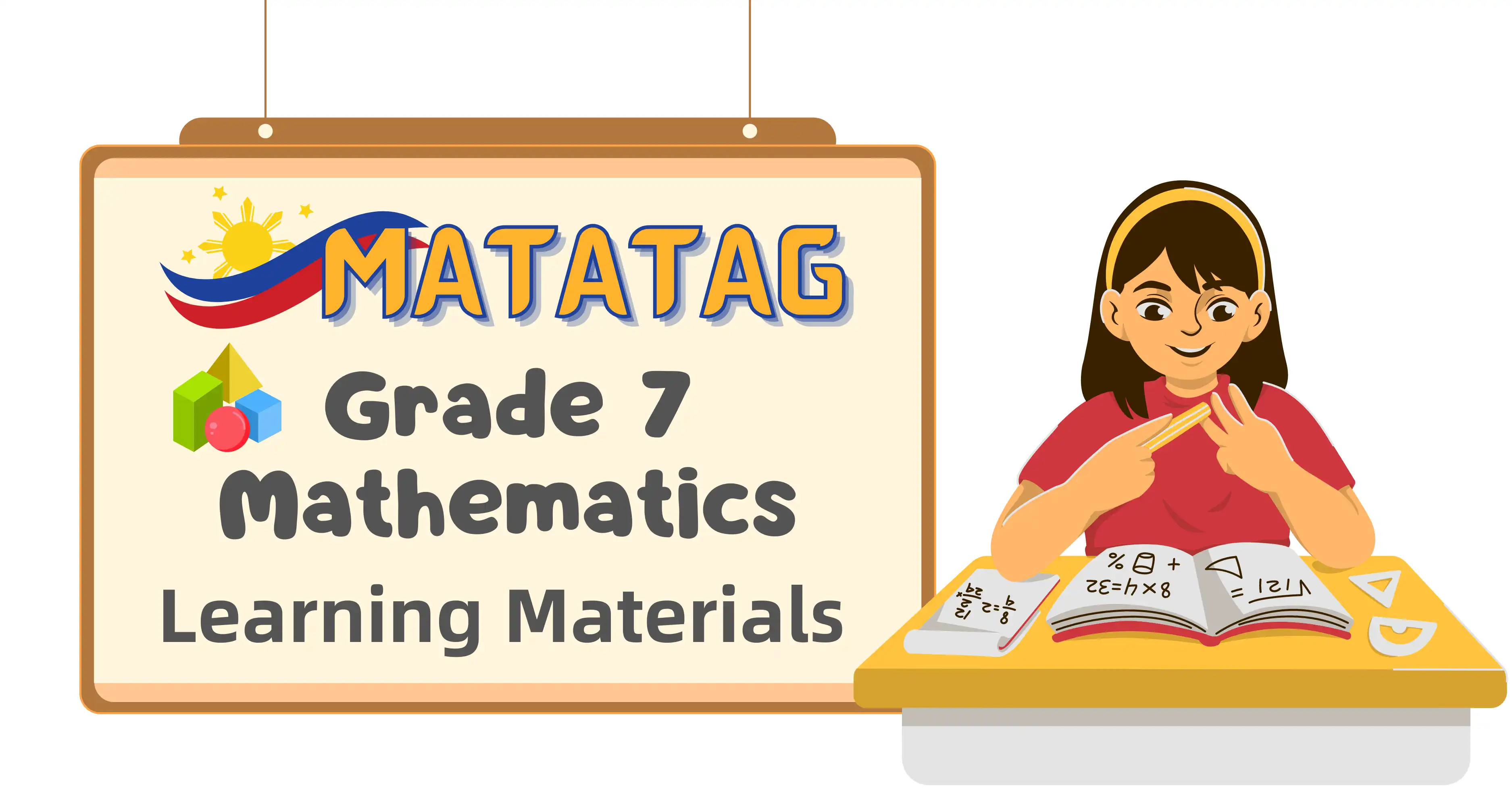Grade 7 Learning Materials
Grade Level Standards
According to the MATATAG Curriculum, here’s what Grade 7 Mathematics students are expected to master. Learners should show their knowledge, skills, and understanding in the following areas:
Number and Algebra: This includes applying percentages, using rates, understanding rational and irrational numbers, and performing operations with integers. Students should also be familiar with square and cube roots, sets and subsets, Venn diagram, and scientific notation. They should be able to solve simple equations, simplify numerical expressions involving integers, and evaluate and rearrange algebraic formulas.
Measurement and Geometry: Students need to know the properties of regular and irregular polygons, how to measure angles and determine the number of sides of polygons, and how to convert units of measurement. They should also understand how to calculate the volume of square and rectangular pyramids and cylinders.
Data and Probability: This involves collecting and sampling data, presenting data in tables and graphs, interpreting statistical graphs, and understanding experimental outcomes.
These learning materials feature engaging illustrated reading resources and interactive activities designed to help students master key learning competencies. They are thoughtfully crafted primarily based on the lesson exemplars provided by DepEd. All copyright belong to the rightful owners.
Quarter 1
Performance Standards
By the end of the quarter, the learners are able to…
- draw, and describe the features/properties of, regular and irregular polygons.
- use percentages in different contexts.
- identify and use rates.
- create a financial plan.
- describe, order, and perform operations on, rational numbers.
1.1a Properties and Classifications of Polygons
1.1a Properties and Classifications of Polygons
LEARNING OBJECTIVES Define a polygon and describe its properties. Classify polygon according to number of sides. Name polygon and its parts. What is a Polygon? A polygon is a flat shape ...
1.1b Interior Angles of Polygons
1.1b Interior Angles of Polygons
LEARNING OBJECTIVES Identify measure of angles of polygons. Determine the measure of each angle of regular polygons. Review Let’s see if you still remember the definition and types of poly...
1.1c Formative Assessment
1.1c Formative Assessment
This assessment will help you review and strengthen your understanding of polygons, their properties, and how to classify and name them. It’s a great opportunity to check what you’ve learned so far...
1.2a Convex or Non-Convex Polygon
1.2a Convex or Non-Convex Polygon
LEARNING OBJECTIVES Describe convex and non-convex polygons. Classify polygons whether they are convex or non-convex. Review Before we proceed to the main lesson, let us have a recall on t...
1.2b Angle Pairs
1.2b Angle Pairs
LEARNING OBJECTIVES Describe complementary, supplementary, adjacent, linear pair, and vertical angles. Explain the relationships between these angle pairs. Review Before we proceed, let’s ...
1.2c Formative Assessment
1.2c Formative Assessment
This assessment will help you review and strengthen your understanding of convex and non-convex polygons as well as the various angle pairs. It’s a great chance to see how much you’ve learned, ther...
1.3a Exterior and Interior Angles of Polygons
1.3a Exterior and Interior Angles of Polygons
LEARNING OBJECTIVES Identify exterior angles and its adjacent interior angles of a polygon. Explain the relationship between exterior angles and its adjacent interior angles. Interior Angle...
1.3b Computing Exterior Angle and its Adjacent Interior Angle
1.3b Computing Exterior Angle and its Adjacent Interior Angle
LEARNING OBJECTIVES Compute for the measure of the exterior angle given the adjacent interior angle and vice versa. Review From the previous reading, we defined exterior angle as the angle fo...
1.3c Solving Measure of Angles and Number of Sides of Polygons
1.3c Solving Measure of Angles and Number of Sides of Polygons
LEARNING OBJECTIVES Determine the measure of angles and number of sides of polygons Review Let’s start with a quick refresher on the names of polygons based on their sides. Check out the int...
Quarter 2
Performance Standards
By the end of the quarter, the learners are able to…
- determine square roots of perfect squares and cube roots of perfect cubes, and identify irrational numbers.
- convert units of measure from different systems of measure.
- find the volume of square and rectangular pyramids, and the volume of cylinders.
- describe sets and their subsets, and the union and intersection of sets.
- illustrates sets and subsets, and union and intersection of sets, using Venn diagrams.
Oops! It looks like there are no learning materials available for Quarter 2 just yet. Stay tuned—content is coming soon!
Quarter 3
Performance Standards
By the end of the quarter, the learners are able to…
- collect data, and organize data in a frequency distribution table.
- represent and interpret data in different types of graphs.
- compare and order integers, including through the use of the number line.
- perform the four operations with integers.
- simplify numerical expressions involving integers.
- identify the absolute value of an integer.
Oops! It looks like there are no learning materials available for Quarter 3 just yet. Stay tuned—content is coming soon!
Quarter 4
Performance Standards
By the end of the quarter, the learners are able to…
- solve simple equations.
- substitute into an algebraic expression to evaluate the expression.
- rearrange a formula to make a different variable the subject of the formula.
- gather data from experiments and represent the data in different forms.
- write numbers in scientific notation and perform operations on numbers written in scientific notation.
Oops! It looks like there are no learning materials available for Quarter 4 just yet. Stay tuned—content is coming soon!
